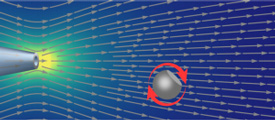Researchers Measure Flow from a Nanoscale Fluid Jet
Jet measures 20 to 150 nanometers in diameter — just a few hundred water molecules across
Fluid jets are all around us: from inkjet printing, to the “Old Faithful” geyser in Yellowstone National Park, to cosmological jets several thousand light years long.
A Northwestern University researcher with collaborators from Cambridge University, Oxford University, and Centro Nacional de Biotecnología have recently verified the classical Landau-Squire theory in the tiniest submerged jet. The diameter of their jets were in the range of 20 to 150 nanometers, which is the length of just a few hundred water molecules lined up in a row.
“The flow rate from this nanojet is in the range of tens of pico liters per second,” said Sandip Ghosal, associate professor of mechanical engineering and (by courtesy) engineering sciences and applied mathematics at Northwestern’s McCormick School of Engineering and Applied Science. “At this rate, if you had started to fill a two-liter soda bottle at the time the first pyramid was being built in Egypt, the bottle would be about half full now.”
 A paper describing the research, “A Landau-Squire Nanojet,” was published October 14 in the journal Nano Letters.
A paper describing the research, “A Landau-Squire Nanojet,” was published October 14 in the journal Nano Letters.
The nanojet is designed around a glass “nano capillary,” which the researchers fabricated by heating an ordinary glass capillary — a hollow glass tube — with a laser and gently pulling it until it broke, creating a fine tip. The researchers applied an electric voltage across the capillary, which was submerged in a salt solution to create an electroosmotic flow that then emerged as a jet.
To measure the jet stream, the researchers built a tiny anemometer — a windmill-like device used for measuring wind speed — from a polystyrene bead less than one-fiftieth the width of a human hair. The bead was held in place by an “optical trap,” a finely focused laser beam that served as a spindle for the tiny anemometer. When the bead was positioned in front of the jet, it spun around, and a video camera picked up tiny fluctuations of light from a dimple on the bead.
The novel anemometry technique allowed the researchers to map out the vorticity and velocity fields of the nanojet and compare it to those predicted by the classical Landau-Squire solution of the Navier–Stokes equations, the 200-year-old equations that form the bedrock of classical physics. Their observations proved to be in remarkable agreement with the theory.
 “The Navier-Stokes equations and everything derived from it are expected to go awry as we approach molecular scales, but no one knows how far down one can push before it breaks,” Ghosal said. “We found that it works very nicely down to tens of nanometers.”
“The Navier-Stokes equations and everything derived from it are expected to go awry as we approach molecular scales, but no one knows how far down one can push before it breaks,” Ghosal said. “We found that it works very nicely down to tens of nanometers.”
The researchers also observed a phenomenon they call flow rectification: an asymmetry in the flow rate with respect to voltage reversal. They found that when the voltage is reversed, the capillary sucks in fluid as expected, but at a much lower rate. The capillary thus behaves like a semiconductor diode — an electronic “valve” that allows current flow in only one direction — but with fluid flowing in place of electrons.
The nanojet has a number of potential novel applications. One possible use is as an ultra-low-volume injector for transferring biomolecules into cells or vesicles, a process used in recombinant DNA technologies important in the production of human insulin and disease-resistant crops. Other possibilities include use as a “flow rectifier” in microfluidic logic circuits, the functional equivalent of semiconductor diodes in microelectronics, and also in applications involving nanoscale patterning and micro manipulation.
In addition to Ghosal, other authors include Nadanai Laohakunakorn and Ulrich F. Keyser of the University of Cambridge; Benjamin Gollnick and Fernando Moreno-Herrero of the Centro Nacional de Biotecnología; and Dirk G. A. L. Aarts and Roel P. A. Dullens of the University of Oxford. The research was conducted earlier this year when Ghosal was Leverhulme Trust Visiting Professor at the Cavendish Laboratory of Cambridge University.